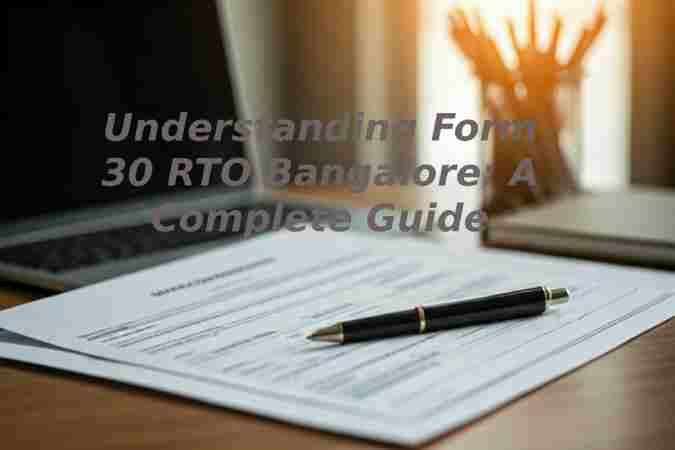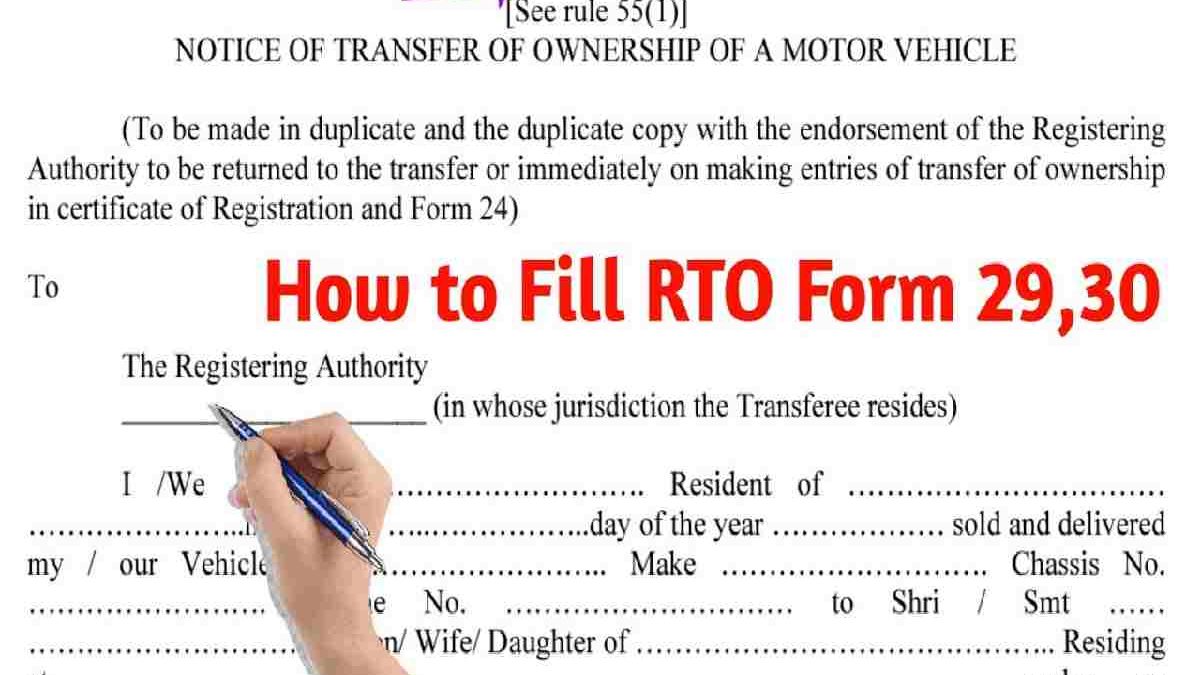Table of Contents
Introduction

Form 30 RTO : When you want to transfer the ownership of a motor vehicle, you need to follow the correct steps. Form 30 is an important paper that you have to give to the registering authority. It is used to show that the transfer of ownership is done, and all legal checks are complete. This form goes along with Form 29 to make sure every job linked to the vehicle is handed over. In Bangalore, you must give in this form with the registration certificate at the right time. Doing this keeps your paperwork in order. It also protects both the buyer and the seller during the registration and the transfer of ownership process.
What is Form 30?
Form 30 is called the “Report of Transfer of Ownership of a Motor Vehicle.” The applicant must give this legal paper to the registering authority when they want to go ahead with a transfer of ownership of a motor vehicle. This RTO form updates the new owner’s details in the paperwork. It also makes sure the previous owner is not legally tied to the vehicle anymore, so their name is cleared from it.
The form is not hard to use and has four main reasons. It collects information about the buyer and the seller. It checks if the transfer of ownership of a motor vehicle is allowed. For vehicles bought with a loan, it tells the people who gave the money, if needed. Lastly, it has the official endorsement from the registering authority which makes everything proper.
When you fill out and hand in Form 30, you should give details like the registration certificate number, both seller and buyer information, and write down that there has been a transfer of ownership of a motor vehicle. This step-by-step registration keeps both the seller and the buyer safe. It helps them follow all the RTO rules, so everything goes smoothly, and no one gets into any trouble.
Why Form 30 is Required for Vehicle Transfers in Bangalore
In Bangalore, you must give Form 30 to the RTO Bangalore when you want to make the transfer of ownership official. The Motor Vehicles Act says this step is needed. The form makes sure the new owner takes on all the legal duties to do with the vehicle. This means the seller is no longer responsible for what happens with it.
You also have to send the certificate of registration with the form when you apply. This helps the transfer go smoothly. If you do not give in this certificate, the registration details in the official list stay with the old owner. That can cause problems, like fines or if there is a fight over the vehicle later.
Telling the registering authority by handing in Form 30 is like a safety step for sellers. It helps make sure vehicle-related things like taxes or any future penalties now belong to the new owner. This written notice gives both people a clear record and keeps them safe from legal problems that might come up later.
Key Differences Between Form 30 and Other RTO Forms
While there are many forms you may need to fill out when you buy or sell a car, Form 30 is the one that shows the transfer of ownership is done. This form does not do the same job as things like a no objection certificate (NOC). The NOC makes sure there are no problems with moving the car to a new person. On the other hand, Form 30 just updates who owns the car.
Other RTO forms, like Form 29, focus more on telling about the change. But Form 30 is all about making sure the new person’s name is on the records. This makes it an important step to finish the transfer of ownership when you get or sell a car.
Comparison with Form 29: Notice of Transfer
Both Form 29 and Form 30 are important in the transfer of a vehicle’s ownership. They go together, but each one has its own main use:
| Aspect | Form 29 | Form 30 |
| Purpose | Lets the RTO know you want to transfer ownership | Confirms you want the change and asks to update registration |
| Submitted By | Transferor (Seller) | Both Transferor and Transferee |
| Focus | Starts the process | Makes the change official and legal |
| Necessity | Must do before sending in Form 30 | Needed to finish the transfer |
Form 29 lets the RTO know about the plan to transfer a car, while Form 30 confirms the new registration details and helps the RTO officially approve the change. To have a smooth ownership change, you will need to fill out and give both forms. The transferor and transferee both play a role in the process at the RTO.
When to Use Form 30 Instead of Form 28 or 35
Knowing the right time to use Form 30 instead of Form 28 or Form 35 helps make the transfer easy with the RTO.
- Form 28 is needed when you want a No Objection Certificate (NOC). This is usually used if you plan to move your vehicle to another state or want to get changes done. Form 35 is used when you want to end a loan or a lease connected to your vehicle.
- Form 30 must be filled out when you need to confirm the transfer of ownership. This form is not used for permissions like Form 28. It just helps the seller and buyer shift the responsibility of the vehicle.
- If your vehicle is on loan or under a lease, you need to handle Form 35 first and get clear on the loan or lease. After that is sorted, use Form 30 to finish the transfer of ownership as per RTO rules. Doing things in the right order helps you meet every guideline.
Step-by-Step Guide to Filling Out Form 30
Filling out Form 30 is not hard, but you need to be careful. Start by putting the name of the applicant and the registering authority in the right spaces. You have to include details about both the seller and buyer, like their addresses. Do not forget to add the thumb impression of the registered owner.
If you make a mistake in these first sections, the process can take longer. Look over each part well before you move on. At the end of the form, all people signing have to put their names. This makes the agreement final before you give it to the rto. Now, let’s go through the main parts of the form.
Detailed Instructions for Each Section of the Form
To make sure there are no mistakes, follow these steps while filling out each part of Form 30 for the transfer of ownership:
- Part A: Write down all the seller’s information. This will have the certificate of registration number, some details about the vehicle, and a statement that shows the seller has given the needed documents to the new owner.
- Part B: Put in the buyer’s full details, including their name, proof of address, and when the purchase took place.
- Part C: If there is a lease or an agreement where money is owed (like hypothecation), make sure to get the financer’s permission with their signature.
- Part D: The registering authority will add an official endorsement to prove the final transfer has happened.
You should also add the effective date of the transfer of ownership and the RTO’s own reference number. Try not to miss any of these details or make any errors so the registration and transfer goes well.
Common Mistakes to Avoid When Completing Form 30
Avoid these common mistakes that can slow down your Form 30 application:
- Missing Signatures: Make sure you get the thumb impression of the registered owner and the financier on every part where it’s needed.
- Incorrect Details: Look at the form again to check every spelling, address, and the number on the registration certificate. Any small mistake could lead to a delay.
- Incomplete NOC: If your car is leased, it is important that the No Objection Certificate is current and complete.
- Stamp Imprint Errors: The official stamp on the form should partly cover the signatures in the correct way.
If you follow these steps, your transfer of vehicle ownership is likely to go smoothly.
Keep reading to know the documents you need to add with Form 30.
Essential Documents Needed with Form 30 Submission
Essential documents are very important when you give Form 30 at the RTO. The main things you need are the original registration certificate, proof of address, and the thumb impression of the registered owner. You also will need a no objection certificate, or NOC, if the vehicle is part of any loan or lease. The applicant has to show a government ID as well for checking. If you have all these in order, the transfer of ownership will go well and it will follow the Motor Vehicles Act.
Mandatory Documents Checklist
A close check of the needed documents is key for a smooth submission. You need the identity proof of both the transferor and the transferee, such as a government ID. The registration certificate (RC) of the vehicle and the certificate of insurance are both important. The application should also have the thumb impression of the registered owner and proof of address. If the vehicle was bought with a loan or on lease, make sure to add the no objection certificate (NOC). This step helps your application be full and ready.
Additional Documents for Special Cases (Loan, Lease, etc.)
Some situations like loans or leases need extra paperwork for a smooth transfer of ownership. If the vehicle is still under loan, the bank will ask for a no objection certificate (NOC). This certificate proves that the loan has been settled, or it can be moved to another person. For a leased vehicle, you need to give a copy of the lease agreement. You also have to provide the thumb impression of the registered owner. When you add all these documents, the registering authority can handle things faster and the transfer process will move quickly.
Conclusion
Completing the Form 30 submission process the right way helps make the transfer of ownership of a motor vehicle easy. This protects both the person giving up the vehicle (transferor) and the person getting it (transferee). Knowing what documents you need to bring helps you get through the RTO faster. It also makes sure you are following the Motor Vehicles Act. You should have all the paperwork ready. This includes the registration certificate, the certificate of insurance, and proof of address. When you hand in all these the right way, the RTO will give an official endorsement showing the transfer of ownership of a motor vehicle is done. The records will now be in the new owner’s name.

